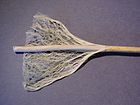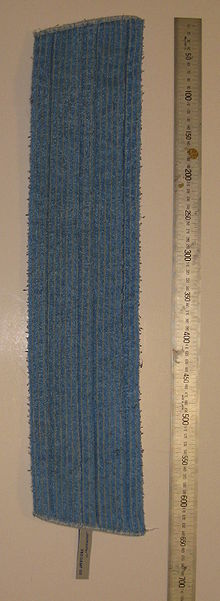- Microfiber
-
Microfiber or microfibre refers to synthetic fibers (fiber) that measure less than one denier. The most common types of microfibers are made from polyesters, polyamides (e.g., nylon, kevlar, nomex, trogamide), and or a conjugation of polyester and polyamide.
Microfiber is used to make non-woven, woven and knitted textiles. The shape, size and combinations of synthetic fibers are selected for specific characteristics, including: softness, durability, absorption, wicking abilities, water repellency, electrodynamics, and filtering capabilities.
Microfiber is commonly used for apparel, upholstery, industrial filters and cleaning products.
Contents
Material
Microfiber is a fiber with less than 1 denier per filament. (Denier is a measure of linear density and is commonly used to describe the size of a fiber or filament. Nine thousand meters of a 1-denier fiber weigh one gram.) Fibers are combined to create yarns. Yarns are knitted or woven in a variety of constructions. While many microfibers are made of polyester, they can also be composed of polyamide or other polymers.
History
Production of ultra-fine fibers (less than 0.7 denier) dates back to the late 1950s, using melt-blown spinning and flash spinning techniques. However, only fine staples of random length could be manufactured and very few applications could be found.[1] Experiments to produce ultra-fine fibers of a continuous filament type were made subsequently, the most promising of which were run in Japan during the 1960s by Dr. Miyoshi Okamoto.[2] Okamoto's discoveries, together with those of Dr. Toyohiko Hikota, resulted in many industrial applications. Among these was Ultrasuede, one of the first successful synthetic microfibers, which found its way onto the market in the 1970s. Microfiber use in the textile industry then expanded.[3] Microfibers were first publicized in the early 1990s in Sweden and saw success as a product in Europe over the course of the decade.[4] In 2007, Rubbermaid began a line of microfiber products for American markets, the first major company to do so.[4]
Functional uses
Clothing
Microfiber apparel is often used for athletic wear, such as cycling jerseys, because the microfiber material wicks moisture (sweat) away from the body, keeping the wearer cool and dry. Microfiber is also very elastic, making it suitable for undergarments. Microfibers were used by the US military and many federal agencies, such as in the Future Force Warrior Program in the United States[citation needed] as they dried rapidly and caused less skin irritation due to moisture[citation needed], but the U.S. military has since banned the wearing of most synthetic clothing due to melting and burn risk.[5]
Microfiber is also used to make tough, very soft-to-the-touch materials for general clothing use, often used in skirts and jackets. Microfiber can be made into Ultrasuede, an animal-product-free imitation suede that is cheaper and easier to clean and sew than real suede.
Insulation
Microfiber materials such as PrimaLoft are used for thermal insulation as a replacement for down feather insulation in sleeping bags and outdoor equipment, due to their better retention of heat when damp or wet.[6]
Basketballs
With microfiber basketballs already popular worldwide and in FIBA[citation needed], the NBA proposed the use of a microfiber ball for the 2006–07 season.[7] The ball, which is manufactured by Spalding, does not require a "break-in" period of use as leather balls do, and has the ability to absorb water and oils, meaning that sweat from players touching the ball is better absorbed, making the ball less slippery.[7] Over the course of the season, the league received many complaints from players who found that the ball bounced differently from leather balls, and that it left cuts on their hands.[8] On January 1, 2007, the league scrapped the use of all microfiber balls and returned to leather basketballs.[8]
Cleaning
Microfiber products used for consumer cleaning are generally constructed from split conjugated fibers of polyester and polyamide. Microfiber used for commercial cleaning products also includes many products constructed of 100% polyester microfiber. Fabrics made with microfibers are exceptionally soft and hold their shape well. When high-quality microfiber is combined with the right knitting process, it creates an extremely effective cleaning material. This material can hold up to eight times its weight in water. Microfiber products have exceptional ability to absorb oils, and are not hard enough to scratch even paintwork unless they have retained grit or hard particles from previous use.
Microfiber is widely used by car detailers to handle tasks such as removing wax from paintwork, quick detailing, cleaning interior, cleaning glass, and drying. Due to their fine fibers which leave no lint or dust, microfiber towels are used by car detailers and enthusiasts in a similar manner to a chamois leather.
Microfiber is used in many professional cleaning applications, for example in mops and cleaning cloths. Although microfiber mops cost more than non-microfiber mops, they may be more economical because they last longer and require less effort to use.[9][10]
Microfiber textiles designed for cleaning clean on a microscopic scale. According to tests using microfiber materials to clean a surface leads to reducing the number of bacteria by 99%, whereas a conventional cleaning material reduces this number only by 33%.[11] Microfiber cleaning tools also absorb fat and grease and their electrostatic properties give them a high dust-attracting power[citation needed].
Microfiber cloths are used to clean photographic lenses as they absorb oily matter without being abrasive or leaving a residue, and are sold by major manufacturers such as Sinar,[12] Nikon and Canon. Small microfiber cleaning cloths are commonly sold for cleaning computer screens and eyeglasses.
Microfiber is unsuitable for some cleaning applications as it accumulates dust, debris, and particles. Sensitive surfaces (such as all high-tech coated surfaces e.g. CRT, LCD and plasma screens) can easily be damaged by a microfiber cloth if it has picked up grit or other abrasive particles during use. The cloth itself is generally safer to use on these surfaces than other cloths, particularly as it requires no cleaning fluid. One way to minimize the risk of damage to flat surfaces is to use a flat, non-rugged microfiber cloth, as these tend to be less prone to retaining grit.
Cleaning textiles made of microfiber must only be washed in regular washing detergent, not oily, self-softening, soap-based detergents. Fabric softener must not be used. The oils in the softener and self-softening detergents will clog up the fibers and make them less effective until the oils are washed out.
Other textile uses
Microfibers used in tablecloths, furniture, and car interiors are designed to repel liquids and consequently are difficult to stain. Microfiber tablecloths will bead liquids until they are removed and are sometimes advertised showing red wine on a white tablecloth that wipes clean with a paper towel. This and the ability to mimic suede economically are common selling points for microfiber upholstery fabrics (e.g. for couches).[citation needed]
Microfibers are used in towels especially those to be used at swimming pools as even a small towel dries the body quickly. They dry quickly and are less prone than cotton towels to become stale if not dried immediately. Paradoxically, microfiber towels need to be soaked in water and pressed before use, as they would otherwise repel water as microfiber tablecloths do.
Environmental and safety issues
Microfiber textiles tend to be flammable and emit toxic gases when burning.[citation needed] They are made with synthetic fibers such as polyester and nylon which are made from petrochemicals. Microfibers are not made from a renewable resource and are not biodegradable.
For most cleaning applications they are designed for repeated use rather than being discarded after use[4] (an exception is the precise cleaning of optical components where a 'wet' cloth is drawn once across the object and must not be used again as the debris collected and now embedded in the cloth may scratch the optical surface). In many household cleaning applications (washing floors, furniture, etc.) microfiber cleaning fabrics can be used without detergents or cleaning solutions which would otherwise be needed.
References
- ^ Nakajima T, Kajiwara K, McIntyre J E, 1994. Advanced Fiber Spinning Technology. Woodhead Publishing, pp. 187–188
- ^ Kanigel, Robert, 2007. Faux Real: Genuine Leather and 200 Years of Inspired Fakes. Joseph Henry Press, pp. 186–192
- ^ Microfiber.com, What is microfiber?
- ^ a b c Barbara Flanagan, The Case of the Missing Microfiber. I.D., April 22, 2008.
- ^ [1]
- ^ PrimaLoft Outdoor
- ^ a b NBA Introduces New Game Ball. NBA.com, June 28, 2006.
- ^ a b Josh Hart, NBA to Take Microfiber Basketball and Go Home. National Ledger, December 12, 2006.
- ^ UC Davis Health System: Newroom. UC Davis Pioneers Use of Microfiber Mops in Hospitals: Mops reduce injuries, kill more germs and reduce costs. June 23, 2006.
- ^ Sustainable Hospitals Project, University of Massachusetts Lowell. 10 Reasons to Use Microfiber Mopping.
- ^ UC Davis Health System: Newroom UC Davis Pioneers Use Of Microfiber Mops In Hospitals. Ucdmc.ucdavis.edu. Retrieved on 2010-12-01.
- ^ Microfibre cloths Camera & Lens Microfibre Cleaning clothes with Instructions
Fibers Natural 
Synthetic CelluloseCategories:- Synthetic fibers
- Fabrics
- Technical fabrics
Wikimedia Foundation. 2010.



